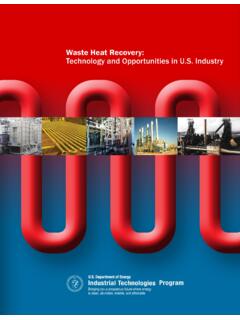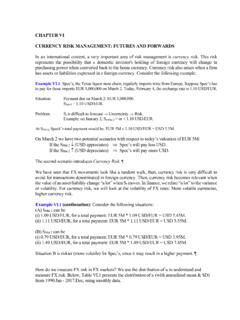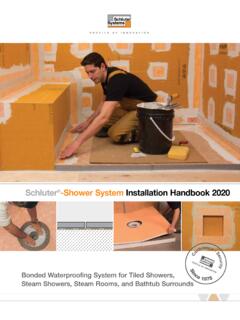Transcription of 6th EDITION Florida High Wind Concrete and Clay Tile ...
1 Florida high wind Concrete and Clay Tile Installation Manual6th EDITIONFRSA TRI Alliance December 31, 2020 (12-31-20)FRSA TRIFRSA-TRI Florida high wind Concrete and Clay Tile Installation Manual 6th EDITION 12/31/206th EDITIONPREFACEThe Tile Roofing Industry Alliance (TRI) in partnership with the Florida Roofing and Sheet Metal Contractors Association, Inc. (FRSA) have been working together for over two decades on the development of installation manuals that represent proper installation practices, industry standards and the latest code requirements of roof tiles for the Florida was the consensus of a joint committee that we should re-write this manual in a way that addresses the latest wind codes, eliminates system designations, recognizes the latest products, reduces redundancy.
2 Adds drawings and paints a clear picture that provides clarity for contractors and inspectors regarding which prod-ucts and processes are acceptable in the high wind regions. The committee also adopted the recommen-dations of several premium upgraded products and enhanced installation practices to improve the long-term performance of tile roofing systems. The culmination of the committee s efforts led to the creation of this 6th EDITION Florida high wind Concrete and Clay Tile Installation Manual for high wind Applications in ON USE AND DISCLAIMER FOR THE FRSA-TRI INSTALLATION GUIDET hese tile guidelines are a consensus document developed by a joint committee of the Florida Roofing and Sheet Metal Contractors Association, Inc.
3 (FRSA) and the Florida Committee of the Tile Roofing Industry Alli-ance (TRI). It is important to recognize that these recommendations are neither warranties, explicit or implicit, or representative of the only method by which a tile system can be installed. Rather, they try to summarize for the designer, applicator or developer good roofing practices and some of the industry standards for the instal-lation of the roof tiles which have been developed over time from actual trade practice and the requirements of various building code agencies. These guidelines may not be applicable in all geographical areas.
4 It is the re-sponsibility of those individuals who are referring to these guidelines to independently research and determine which method is best for their particular recommendations contained herein address Concrete and clay tile installations in Florida ; however these recommendations may be utilized in other geographical areas designated as a high wind region. The TRI offers installation manuals for basic Climate regions as well as Cold and Snow regions. For more information, visit the TRI website or email manner in which tile roofs are installed in high wind regions makes them a highly-effective water shed-ding assembly that affords years of service and protection.
5 The effectiveness of a tile roof system as a weather resistant assembly depends upon the proper installation of the tile roof components, because installing them properly is critical to the performance of the installed should be noted that several formatting changes have been continued in this revision. First, the table for underlayment and flashings (see page 6) addresses the compatibility of one-ply and two-ply underlayments, attachment methods and flashing types, as well as the possible need for additional flashings and sealants. The second table is for hip and ridge attachment methods (see page 14) and denotes the various approved meth-ods for installing hip and ridge tiles, as well as the compatible weather blocking treatments.
6 The implementa-tion of these tables will help reduce the likelihood of the inadvertent mixing of systems, which can lead to a reduction in the life span of a tile roof manual has been divided into two sections of content. The first contains text and tables; the second contains detailed drawings that supplement the text. Several new drawings have been added, while some that were found to be redundant or unnecessary in prior manuals were should be familiar with local codes and wind zone designations when choosing a tile roof system. For more information, please contact the Tile Roofing Industry Alliance (TRI) or the Florida Roofing and Sheet Metal Contractors Association, Inc.
7 (FRSA). Initial publication date 9/18, effective code date 12/31 TRI2 FRSA-TRI 12/31/206th EDITIONTABLE OF CONTENTSSPECIFICATIONSG eneral Overview ..3 Products ..3 Underlayment & Flashings ..6 INSTALLATIONS ingle-Ply System ..7 Two-Ply System ..8 Metal Installation ..12 Hip and Ridge Installation ..14 APPENDIX ARoof Project Design Flow Chart and Examples ..17-21 Uplift and Design Pressure Tables ..22-31 ASCE 7-16 wind Map For Exposure C ..32 APPENDIX BDrawings ..33-48 APPENDIX CGlossary ..49-53 FRSA TRI3 FRSA-TRI Florida high wind Concrete and Clay Tile Installation Manual 6th EDITION 12/31/206th EDITIONSPECIFICATIONSGENERAL OVERVIEWR elated Work Specified Elsewhere Other trades such as Rough Carpentry Section 06 10 00, Roof and Deck Insulation Section 07 22 00, Flashing and Sheet Metal Section 07 60 00, and Roof and Wall Specialties and Accessories Section 07 70 00, are not covered by these Assurance Concrete roof tile shall be in compliance with ASTM C1492.
8 Clay roof tile shall be in compliance with ASTM When required, submittals shall include the tile profile, color and manufacturer. A typical sub-mittal package includes product descriptions, recom-mended installation procedures and a conforming Product Approval or current Compliance Delivery, Storage and Handling Distrib-ute stacks of tile uniformly, not in concentrated loads. When conditions warrant, install temporary battens to facilitate roof loading. Care shall be taken to protect the underlayment during the tile loading and stacking Conditions Do not install underlayment over wet surfaces.
9 Ensure other trades are aware and take the necessary precautions when loading materials, roofing and/or stacking of tile is taking place. Any damage that occurs to the underlayment, flashings or battens shall be immediately repaired with like Ventilation or Sealed Attic Systems are required by the building codes. These requirements vary and should be verified by the local jurisdiction. They can be found in Section 1203 of the Florida Building Code and the International Building Code, and in Section R806 of the Florida Residential Code and the International Residential Code.
10 Vents shall comply with ICC-ES AC132 and be installed as per manufacturer s written Refer to specific manufacturer s limited warranty against defects in roof NOTICE The FRSA and TRI Alliance rely on the component industry s data to establish mini-mum physical properties standards for their products. The standards listed in the products section of this man-ual reflect that process. Refer to each manufacturer s Product Approval(s) or Compliance Reports for additional Shall conform to ASTM D312, Type III or IV (Note slope requirements in the building code).







